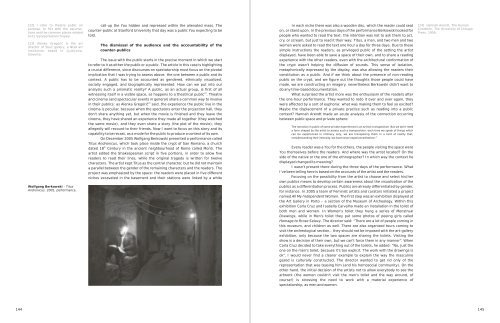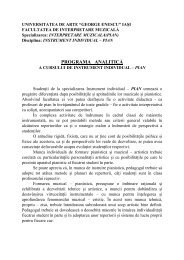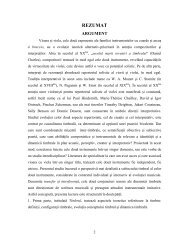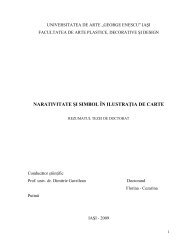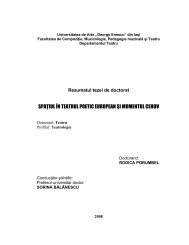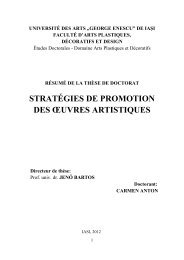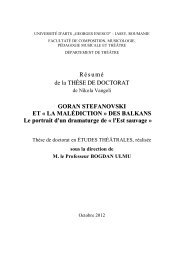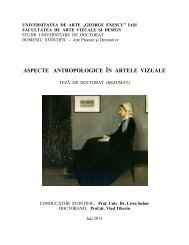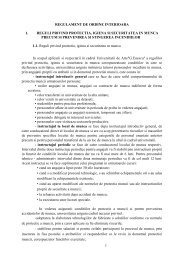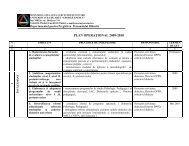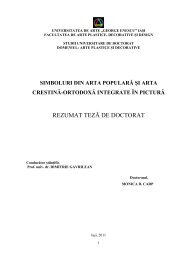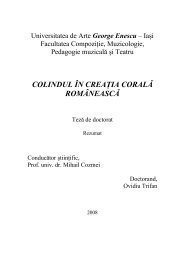vector 2_1.cdr - Universitatea de Arte "George Enescu"
vector 2_1.cdr - Universitatea de Arte "George Enescu"
vector 2_1.cdr - Universitatea de Arte "George Enescu"
You also want an ePaper? Increase the reach of your titles
YUMPU automatically turns print PDFs into web optimized ePapers that Google loves.
144<br />
[22] I refer to theatre public on<br />
purpose, to flirt with the assumptions<br />
and the common places related<br />
to its representation (tropes).<br />
[23] Alenka Gregorič is the art<br />
director of Skuč gallery, a NGO art<br />
institution based in Ljubljana,<br />
Slovenia.<br />
Wolfgang Berkowski - Titus<br />
Andronicus, 2005, performance.<br />
call-up the You hid<strong>de</strong>n and repressed within the alienated mass. The<br />
counter-public at Stanford University that day was a public You expecting to be<br />
told.<br />
The dismissal of the audience and the accountability of the<br />
counter-publics<br />
The issue with the public starts in the precise moment in which we start<br />
to refer to it as either the public or a public. The article in this case is highlighting<br />
a crucial difference, since discourses on spectatorship must focus on the pivotal<br />
implication that I was trying to assess above: the one between a public and its<br />
context. A public has to be accounted as gen<strong>de</strong>red, ethnically visualized,<br />
socially engaged, and biographically represented. How can we put into our<br />
analysis such a prismatic reality? A public, as an actual group, is first of all<br />
22<br />
witnessing itself in a visible space, as happens to a theatrical public . Theatre<br />
and cinema (and spectacular events in general) share a common way to involve<br />
23<br />
in their publics: as Alenka Gregorič said, the experience the public live in the<br />
cinema is peculiar, because when the spectators enter the projection hall, they<br />
don't share anything yet, but when the movie is finished and they leave the<br />
cinema, they have shared an experience they ma<strong>de</strong> all together (they watched<br />
the same movie), and they even share a story (the plot of the movie), they<br />
allegedly will recount to their friends. Now I want to focus on this story and its<br />
capability to be recast, as a mo<strong>de</strong> for the public to produce a context of its own.<br />
On December 2005 Wolfgang Berkowski presented a performance called<br />
Titus Andronicus, which took place insi<strong>de</strong> the crypt of San Romano, a church<br />
th<br />
dated 18 Century in the ancient neighbourhood of Rome called Monti. The<br />
artist edited the Shakespearian script in five portions, in or<strong>de</strong>r to allow five<br />
rea<strong>de</strong>rs to read their lines, while the original tragedy is written for twelve<br />
characters. The artist kept Titus as the central character, but he did not maintain<br />
a parallel between the gen<strong>de</strong>r of the remaining characters and the rea<strong>de</strong>rs. The<br />
project was emphasized by the space: the rea<strong>de</strong>rs were placed in five different<br />
niches excavated in the basement and their stations were linked by a white<br />
In each niche there was also a woo<strong>de</strong>n disc, which the rea<strong>de</strong>r could seat<br />
on, or stand upon. In the previous days of the performance Berkowski looked for<br />
people who wanted to read the text: the intention was not to ask them to act,<br />
cry, or scream, but just to read it their way: Titus, a man, and two men and two<br />
women were asked to read the text one hour a day for three days. Due to these<br />
simple instructions the rea<strong>de</strong>rs, as privileged public of the setting the artist<br />
displayed, have been able to save a space of their own, and to share a reading<br />
experience with the other rea<strong>de</strong>rs, even with the architectural conformation of<br />
the crypt wasn't helping the diffusion of sounds. This sense of isolation,<br />
metaphorically expressed by the display, was also allowing the rea<strong>de</strong>rs their<br />
constitution as a public. And if we think about the presence of non-reading<br />
public on the crypt, and we figure out the thoughts those people could have<br />
ma<strong>de</strong>, we are constructing an imagery, nevertheless Berkowski didn't want to<br />
do any time-based documentation.<br />
What surprised the artist more was the enthusiasm of the rea<strong>de</strong>rs after<br />
the one-hour performance. They wanted to redo it over and over again, they<br />
were affected by a sort of euphoria: what was making them to feel so excited?<br />
Maybe the displacement of a private practice such as reading into a public<br />
context? Hannah Arendt ma<strong>de</strong> an acute analysis of the connection occurring<br />
between public space and private sphere:<br />
The narration in public of some private experiences is an artistic transposition. But we don't need<br />
a form shaped by the artist to assess such a transposition: each time we speak of things which<br />
can be experienced in intimacy only, we are transposing them in a kind of reality that,<br />
24<br />
notwithstanding their intensity, we have never experienced before.<br />
Every rea<strong>de</strong>r was a You for the others, the people visiting the space were<br />
You themselves before the rea<strong>de</strong>rs. And where was the artist located? On the<br />
si<strong>de</strong> of the native or the one of the ethnographer? In which way the context he<br />
displayed changed its meaning?<br />
I wasn't present there during the three days of the performance. What<br />
I've been telling here is based on the accounts of the artist and the rea<strong>de</strong>rs.<br />
Focusing on the possibility from the artist to choose and select his/her<br />
own publics means to <strong>de</strong>velop certain awareness about the visualization of the<br />
publics as a differentiation process. Publics are already differentiated by gen<strong>de</strong>r,<br />
for instance. In 2005 a team of Feminist artists and curators initiated a project<br />
named All My In<strong>de</strong>pen<strong>de</strong>nt Women. The first step was an exhibition displayed at<br />
the Art Gallery in Porto – a section of the Museum of Archeology. Within this<br />
exhibition Carla Cruz and Isabella Carvalho ma<strong>de</strong> an installation in the toilet of<br />
both men and women. In Women's toilet they hung a series of Menstrual<br />
Drawings, while in Men's toilet they put some photos of peeing girls called<br />
Homage to Rrose Selavy. The director said: “There are a lot of people coming in<br />
this museum, and children as well. There are also organized tours coming to<br />
visit the archeological section… they should not be imposed with the art-gallery<br />
exhibition, only because the two spaces are sharing the toilets. Visiting the<br />
show is a <strong>de</strong>cision of their own, but we can't force them in any manner”. When<br />
Carla Cruz <strong>de</strong>ci<strong>de</strong>d to take everything out of the toilets, he ad<strong>de</strong>d: “No, just the<br />
one on the men's toilet, because it's too explicit. The work with the drawings is<br />
ok”. I would never find a clearer example to explain the way the masculine<br />
gazed is culturally constructed. The director wanted to get rid only of the<br />
representation that was teasing him (and his homosocial community). On the<br />
other hand, the initial <strong>de</strong>cision of the artists not to allow everybody to see the<br />
artwork (the women couldn't visit the men's toilet and the way around, of<br />
course!) is stressing the need to work with a material experience of<br />
spectatorship, as men and women.<br />
[24] Hannah Arendt, The Human<br />
Condition, The University of Chicago<br />
Press, 1958.<br />
145


